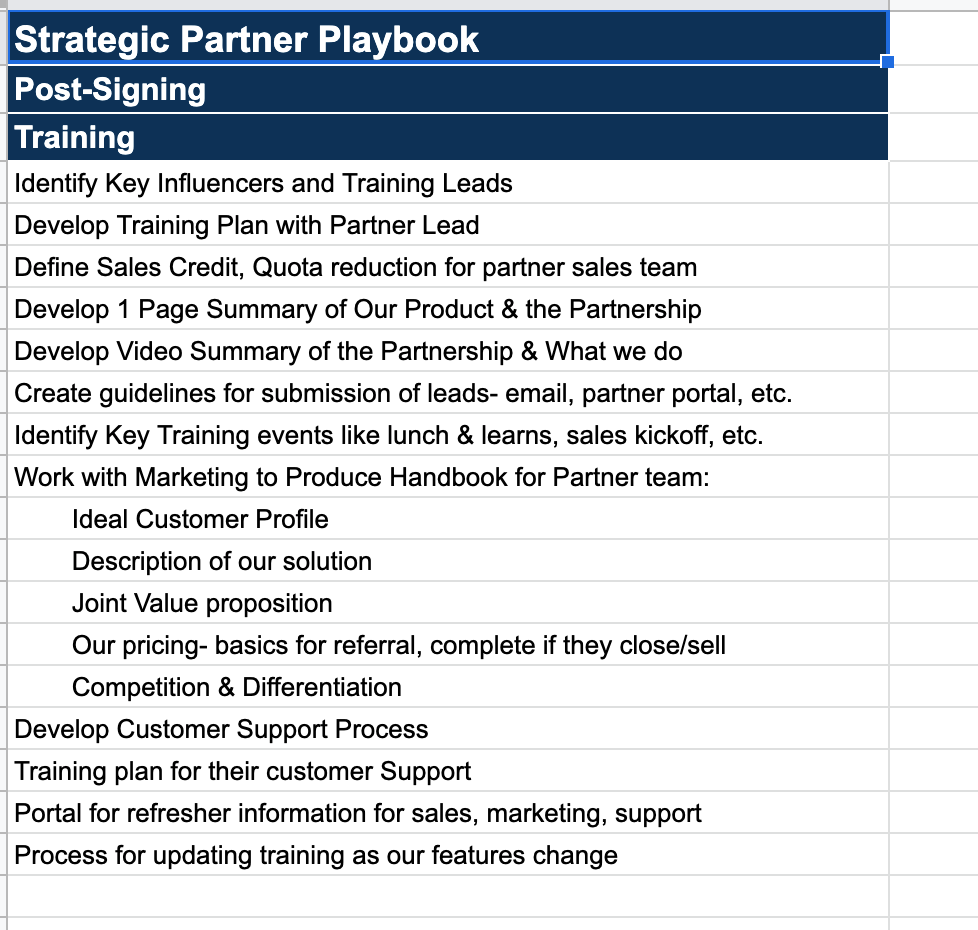5 Reasons You Need a Strategic Alliance Playbook
By Rob Kornblum | Startup
Startups and small businesses have much to gain from building networks of strategic alliances or partnerships. Often, this is a small company partnering with a large company to get access to its customers.
Once you’re sure the time is right for you to really build your alliance program, One of the most important tools you will use is a Strategic Alliance Playbook. This can be similar to a sales playbook—tools that help those sales and marketing know which prospects and customers are the best ones to target, and how best to reach them with an effective sales message.
Similarly, a Strategic Alliance Playbook is an incredibly useful tool to establish or scale a partner program.
What do I mean by a “playbook”? Basically, it’s a document, spreadsheet, or online tool that lays out the status of each partner, what has been done, and what needs to be done. In the past, I have used spreadsheets, but now I find a Google Sheet or AirTable worksheet to work best because everyone has access.
If you want to see a generic example of a Strategic Alliance Playbook I have used, click here
A good Alliance Playbook helps a partner team leader keep everyone on track in going after the right partners and getting them to sign. But the Playbook also defines best practices for what comes after you sign the deal. Effectively launching the partnership, training, co-marketing, and ongoing communication are the keys to maximizing partnership or channel programs.
These best practices for post-signing are the difference between really driving revenue and marketing value, and the opposite, the dreaded “Barney” partnership (“I love you, you love me”).
Over the last 20 years, I have created and led partnership, M&A, and alliance programs in large and small companies. From that experience, I believe there are five major reasons to put together and use an Alliance Playbook.
One place where I see partner programs go off track is that they tend to chase every kind of partner. A good playbook can help you to define the right type of partner company for you to go after.

First, you have to define your goals. Typically, for most startups or small businesses, there are two primary goals in establishing partnerships (but there could be many others). Those are:
Once you have your goals set, you typically try to create a list, or a “map” of prospective companies you can partner with. It’s possible you may already have inbound interest from one company. Either way, you want to answer a number of important background questions about your possible partners. I call this “due diligence” but you might call it background research.
How many clients does the partner have?
Are their clients a good fit for us: size, industry, growth rate, problems they face?
Are we competing with another company for the partnership?
What are possible models for the partnership (referral, reseller, JV, licensing deal, something else)?
What personal relationships do we have already with the prospective partner? Who knows them and how?
Is the partnership within one part of their organization or with all of it?
How are we going to integrate our offering with theirs? Is there technical work to be done?
Does the partner have a structured partner program? Do they have a history of partnering with companies like ours?
Do we have the same goals as our partner?
What is in it for them?
To improve your close rate of large, strategic partners, it helps to manage the outreach and dialog with these companies just like you are trying to sell to a large strategic customer.
Many of us in BD or sales have gone through, or are at least familiar with, the Miller Heiman “Strategic Selling” course and approach to Complex Sales. Partnering with larger companies is very similar to selling to larger companies, so it can help to design your pre-signing approach in a similar manner.
Strategic Selling emphasizes understanding the “buying influences”—people and parts of the organization who have an impact on the purchase decision. The same thing happens in partnerships. Not only is there likely to be a “partnership group” that manages and structures the deal, but other people are almost always involved. Groups like product management, technology/IT/Dev Ops, finance, sales, and others can impact your ability to get a partnership deal done.
Map these influencers out. Make sure you understand the full process of the partner company decision, and try to meet with as many of those influencers and possible. Understand their motivations, and your competition.
Understanding the motivations of different influencers can really help if negotiations slow down or stall. If your negotiating counterpart is saying the right things, but the deal feels stalled, it is likely one of these other influencers who is weighing in. Knowing who they are, and understanding their goals, can help you get creative to get these deals unblocked.
I once negotiated a partnership for a software company with IBM. The deal crossed all three of IBM’s service lines at that time (services, software, and hardware) and was global, with three main geographies. So, even though we had a single champion, there were 9 different sign offs that we needed to get this partnership done.
It really doesn’t matter how many partners you get to sign. What matters is the impact on your company from those partners.
Most of the time, that impact is going to be measured in terms of revenue and marketing. Is the partnership delivering your business goals, most importantly, is it delivering revenue?
The critical steps in making any partnership successful come after the signing.
The Playbook is the key to this activity, because you and the alliance team can all use it to drive a common set of activities across all your partner launches.
This starts with identifying the key participants and influencers. In a large company, this is going to be pretty complex. Your partner can help for sure, but you also need to do some deep research using LinkedIn or more specialized tools like DiscoverOrg, which can help you map the partner company org chart.
One critical step here, that you hopefully discussed during your negotiation phase, is knowing how you are going to compensate your partner’s sales team for closing deals (or referring deals to you that close). Without direct compensation, SPIFFS, or at least quota retirement, the partner’s sales organization probably won’t care about your company.
The next critical step is training the partner sales and marketing team. There are a ton of old school methods (PDFs, lunch & learn’s, etc.) as well as new school one’s (training apps, partner portals, etc.) to go about this. You want to make sure they understand what you do, who your ideal client is, questions to ask the client, and the basics of your pricing model.
Once you have begun your training, it is critical to get the partner’s current customers and prospects to know about your company and offering. This partner marketing activity, and the timing of this activity for the next 6-12 months, is all laid out in your playbook.

There is no way in a blog post I can direct exactly what your partner marketing activity should be without knowing more about your partnership and model, but there are some basics I can recommend for anyone.
Define the joint value proposition
Joint press release (issue by the company with the bigger brand)
Outreach to industry analysts
Current customer marketing (email, webinar, 1 pager, landing pages, etc.)
New customer marketing (webinars, conferences, in person, content/blog posts/ trade publications)
All of this type of activity takes time and costs money. Before you launch your partner program, it’s important to budget for at least some of this and get alignment with your management team and CMO. In an ideal world, you have a partner marketing professional who is dedicated to this.
A great strategic alliances program has regular communication between partners. In order to “fix” things that aren’t working as well as they could, you have to measure them. That’s where a Quarterly Business Review, or QBR, comes into play.
A good Playbook outlines the kinds of things you want to cover in the QBR. It’s not rocket science. How did you do last quarter in generating leads and closed business? What marketing did you do, and how did it work? What training did you do and how did it work?

You also want to set the stage for next quarter and make sure you are aligned on the upcoming activities.
Lastly, you want to make sure the executive sponsors of the deal from both sides have some regular communication, perhaps quarterly but no less than every 6 months. This can be really effective at staying top-of-mind with your partner, and also avoiding any surprises down the road.
About the author:
Rob Kornblum is a 20+ year veteran of all types of partnerships, alliances, joint ventures, channel sales, investing and M&A. He has experience from startups to public companies. To contact Rob about working with you on your partnership program, click here